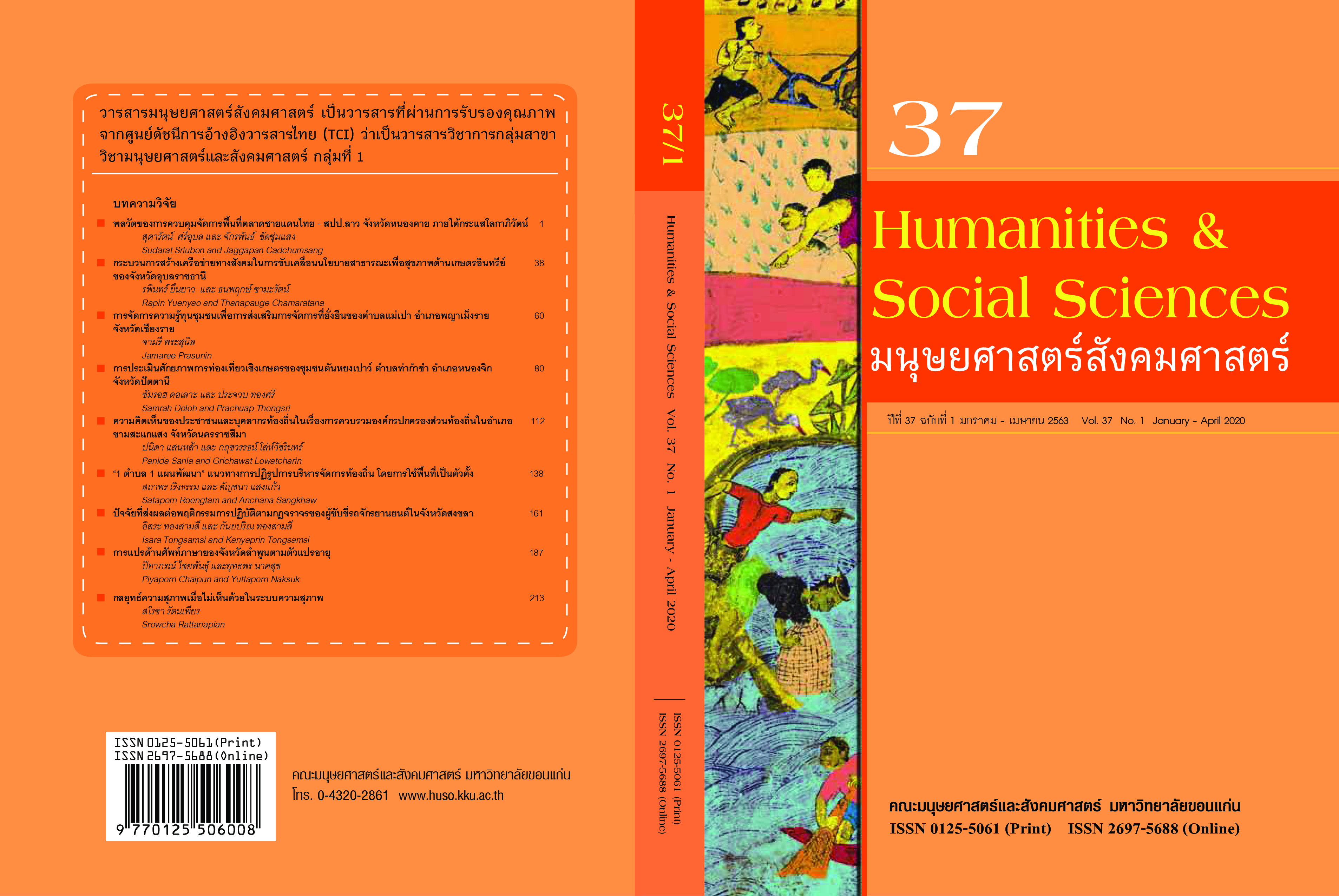พลวัตของการควบคุมจัดการพื้นที่ตลาดชายแดนไทย - สปป.ลาว จังหวัดหนองคายภายใต้กระแสโลกาภิวัตน์
Dynamics of Control and Management in the Thai - Laos Border Marketplace, Nong Khai Province in Globalization
Keywords:
Border Regime, Border Trade Checkpoint, Social Control and Organization in the Thai – Laos Border, New World OrderAbstract
This article primarily deals with the dynamics of Thai-Lao border control at Nong Mon Village Border Trade Checkpoint in Nong Khai Province. Based on qualitative research methodology, the data employed in this article were drawn from reviewed documents as well as fieldwork. The data collection techniques used during the fieldwork comprised in-depth interviews and participant and non-participant observations. The selected key informants included community seniors, Thai government officials, trans-border Laotian petty traders, load carrying workers, tricycle riders, and transported boatmen.
According to the research, upon the end of the Cold War era, the notion known as New World Order was created in order to promote international cooperation in different aspects such as human rights, environments, free trade, copyright and patentability. The aforementioned New World Order has spread throughout the world, including the area of Nong Mon Village Border Trade Checkpoint. Nong Mon is a border community, which people from the both sides of the borderline--the Mekong River-have been closely linked on the basis of kinship as well as ethnic origin. Socio-cultural and economic relations between the people from the both sides of the river have been established for a long time. Since Thailand has been a signatory to the Convention on International Trade in Endangered Species of Wild Fauna and Flora (CITES) and the Greater Mekong Subregion has emerged, the border regime has played a vital role in controlling and monitoring transborder mobilities of people and goods. The functioning of border regime are made possible through the "border trade checkpoint," which was established in the replacement of the "natural trade channel". Such a border regime reflects how the Thai state tries to control and monitor the border zone. As the border area where local people use traditional norms to maintain their crossborder relationship, however, the Thai state cannot exercise its power to control and monitor entire transborder mobilities of people and goods.
References
กรณีศึกษา กัมพูชามองไทย คนไร้รัฐ และเมืองคู่มิตร. อุบลราชธานี: ศูนย์วิจัยสังคมอนุภูมิภาค
ลุ่มน้ำโขง มหาวิทยาลัยอุบลราชธานี.
จักรกริช สังขมณี. (2561). Limology: ชายแดนศึกษา กับ เขต-ขันธ์วิทยาของพื้นที่ใน/
ระหว่าง. กรุงเทพฯ: สยามปริทัศน์.
(2555). สลายเส้นแบ่งพรมแดนไทย-พม่า. วารสารทางวิชาการ คณะสังคมศาสตร์
มหาวิทยาลัยเชียงใหม่, 24(1-2); หน้า 17-61.
ชาย โพธิสิตา. (2547). ศาสตร์และศิลป์แห่งการวิจัยเชิงคุณภาพ. พิมพ์ครั้งที่ 1. กรุงเทพฯ: อมรินทร์พริ้นติ้ง
แอนด์พับลิชชิ่ง.
บุศรินทร์ เลิศชวลิตสกุล. (2561). พลวัตการเคลื่อนย้ายและระบอบควบคุมชายแดนไทย-พม่าบริเวณจังหวัด
แม่ฮ่องสอน. ใน ประเสริฐ แรงกล้า (บ.ก.), ชีวิตทางสังคม ในการเคลื่อนย้าย (Social Life on the Move), หน้า 147-183. กรุงเทพฯ: คณะสังคมวิทยาและมานุษยวิทยา มหาวิทยาลัยธรรมศาสตร์.
ผู้จัดการออนไลน์. (2556). “ค้างาช้าง” ประเด็นใหญ่ในการประชุมไซเตส. (ออนไลน์). สืบค้นเมื่อวันที่
12 มีนาคม 2562. เข้าถึงได้จาก: https://mgronline.com/science/detail/9560000026525
พฤกษ์ เถาถวิล. (2552). พื้นที่ของการดำรงชีวิตในการค้าชายแดน: เขตแดนรัฐ พื้นที่ในระหว่างและ
ภูมิศาสตร์แห่งการครอบงำ/ต่อต้าน. วารสารศิลปศาสตร์ มหาวิทยาลัยอุบลราชธานี, ฉบับพิเศษลุ่ม
น้ำโขงศึกษา, หน้า 1-27.
พฤกษ์ เถาถวิล และสุธีร์ สาตราคม. (2554). MOU การจ้างงานข้ามชาติ: เสรีนิยมใหม่ การคุ้มครองแรงงาน
และการปรับยุทธศาสตร์การกำกับควบคุมของรัฐ. วารสารสังคมลุ่มน้ำโขง, 7(3), หน้า 1-26.
ธโสธร ตู้ทองคำ. (2555). หน่วยที่ 2 วิวัฒนาการสังคมระหว่างประเทศ ใน เอกสารการสอนชุดวิชา
ความสัมพันธ์ระหว่างประเทศ หน่วยที่ 1-8. (ฉบับปรับปรุง). นนทบุรี:
สำนักพิมพ์มหาวิทยาลัยสุโขทัยธรรมาธิราช.
ยศ สันตสมบัติ และคณะ. (2548). อำนาจ พื้นที่ และอัตลักษณ์ทางชาติพันธุ์: การเมืองวัฒนธรรมของรัฐ
ชาติไทย. เชียงใหม่: สำนักงานกองทุนสนับสนุนการวิจัย.
ศุภมิตร ปิติพัฒน์. (2553). เขตแดน / พรมแดน / ชายแดน. กรุงเทพฯ: บริษัท สแควร์ ปริ๊นซ์ 93 จำกัด
สถาบันยุทธศาสตร์ภาคตะวันออกเฉียงเหนือ มหาวิทยาลัยขอนแก่น. (2557). รายงานการศึกษาฉบับสมบูรณ์
การค้าตามแนวชายแดนของจังหวัดหนองคาย. กรุงเทพฯ: กระทรวงมหาดไทย.
Anderson, James and O'Dowd, Liam. (1999). Borders, Border Regions and Territoriality:
Contradictory Meanings, Changing Significance. Regional Studies, 33(7); 593-604.
Appadurai, Arjun. (1996). Modernity at Large: Cultural Dimensions of Globalization.
Minneapolis: University of Minnesota Press.
Berg, E. & Ehin, P. (2006). What kind of border regime is in the making?: Towards a
differentiated and uneven border strategy. Journal of the Nordic International Studies Association, 41(1), 53–71.
Donnan, H., and T. Wilson. (1999). Borders: Frontiers of Identity, Nation, and State.
Oxford and New York: Berg.
Ong, Aihwa. (1999). Flexible Citizenship: The Cultural Logics of
Transnationality. Durham and London: Duke University Press.
Walker, Andrew. (1999). The Legend of the Golden Boat: Regulation, Transport and
Trade in North-Western Laos. Doctor’s Thesis. Australia: The Australian National University.



